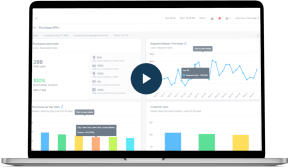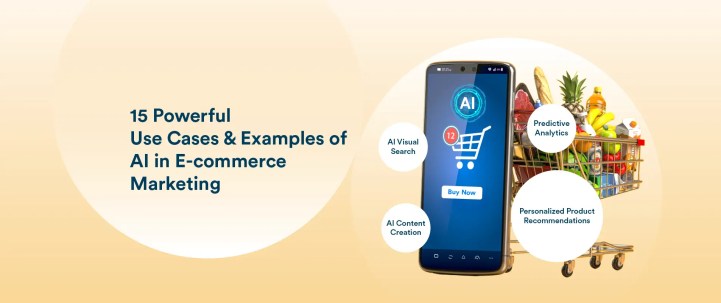In e-commerce, artificial intelligence (AI) is changing how businesses interact with customers and drive revenue growth. AI use cases in e-commerce marketing have reached a pivotal inflection point, with 78% of companies now actively leveraging AI technologies.
The widespread adoption of AI in e-commerce marketing is fueled by clear, measurable gains in both marketing effectiveness and operational efficiency.
Let’s explore the 15 most powerful AI use cases in e-commerce that are shaping e-commerce marketing, complete with implementation strategies, AI in e-commerce examples, and actionable insights.
AI Use Cases in E-Commerce That Drive Real Impact
From hyper-personalized recommendations to intelligent automation, the following AI use cases in e-commerce are changing the way e-commerce brands attract, convert, and retain customers.
1. AI-Powered Personalized Product Recommendations
Personalized product recommendations are one of the most impactful AI use cases in e-commerce, with giants like Amazon attributing 35% of their revenue to these smart suggestion systems.
Implementation Strategy:
- Analyze your top 100 products and identify common purchase patterns.
- Use collaborative filtering algorithms to suggest products based on similar customer profiles.
- Incorporate real-time browsing data to update recommendations dynamically during shopping sessions.
- Create a “Frequently Bought Together” section on product pages, showcasing AI-generated bundles.
- Implement a post-purchase email series with personalized recommendations based on recent purchases.
A great AI in e-commerce example is ASOS, the online fashion retailer. ASOS implemented AI-powered product recommendations, resulting in a 75% increase in email click-through rates and a significant boost in customer engagement. Their “You Might Also Like” feature, powered by AI, has been particularly successful in driving additional sales.
Actionable Tip: Start by focusing on your top 20% of products, which drive 80% of your revenue. Use AI to analyze purchase patterns and create personalized bundles for these high-performing items.
2. Dynamic Content Personalization
AI enables the creation of dynamic content that adapts to user preferences and behavior in real-time, significantly boosting engagement and conversions.
Implementation Strategy:
- Utilize AI for customer segmentation based on behavior, demographics, and purchase history.
- Create dynamic content blocks on your homepage and category pages that change based on user segments.
- Implement A/B testing with AI to optimize content variations for different segments.
- Design 5-10 different homepage layouts with varying hero images, featured products, and call-to-action placements.
- Use AI to track user interactions and assign the most effective layout to each visitor segment.
Actionable Tip: Use AI to predict which content elements are most likely to drive engagement and conversions. Start with your homepage and gradually expand to category pages and product descriptions.
3. AI-Driven Predictive Analytics
Predictive analytics powered by AI is transforming how e-commerce businesses understand and anticipate customer behavior, enabling more accurate forecasting and data-driven decision-making.
Implementation Strategy:
- Implement an AI-powered customer data platform (CDP) to consolidate data from various touchpoints.
- Develop predictive models for key customer actions (e.g., purchase intent, churn risk, customer lifetime value).
- Create automated workflows that trigger personalized campaigns based on predicted behaviors.
- Set up a scoring system that assigns points to different actions, with AI refining the weights over time.
- Use AI to identify cross-sell and upsell opportunities by analyzing purchase patterns across different customer segments.
Ajio, a top fashion e-commerce platform in India, used CleverTap’s predictive analytics capabilities to enhance personalization, engagement, and retention. With churn modeling and real-time recommendations, Ajio improved targeting and campaign timing. AI-powered attribution and conversational tools streamlined customer interactions and boosted marketing ROI.
Actionable Tip: Start by focusing on predicting high-value customer actions, such as the likelihood of purchasing high-margin products or the probability of churn. Use these insights to prioritize your marketing efforts and allocate resources effectively.
4. AI-Powered Chatbots and Virtual Assistants
AI chatbots have revolutionized customer service in e-commerce, handling a wide range of customer queries 24/7 and significantly improving response times and customer satisfaction.
Implementation Strategy:
- Identify the most common customer queries and create a knowledge base for the AI chatbot.
- Implement natural language processing (NLP) to accurately understand and respond to customer inquiries.
- Integrate the chatbot with your product database and order management system for real-time information.
- Use machine learning to improve the chatbot’s responses based on customer interactions continuously.
- Implement sentiment analysis to detect customer frustration and escalate to human agents when necessary.
For example, Whole Foods launched an AI-powered Facebook Messenger chatbot that lets users find recipes using emojis or natural language. It delivers curated recipes, tips, and product suggestions, making meal planning more interactive and fun. The chatbot enhances customer engagement by combining convenience, personalization, and conversational technology.
Actionable Tip: Start with a focused implementation, such as handling order status inquiries or product recommendations. Gradually expand the chatbot’s capabilities as you gather more data on customer interactions.
5. Dynamic Pricing Optimization
AI-powered dynamic pricing allows businesses to optimize their pricing strategies in real-time, potentially increasing revenue by up to 20%.
Implementation Strategy:
- Implement an AI-powered dynamic pricing engine that integrates with your e-commerce platform.
- Define pricing rules and constraints (e.g., minimum profit margins, maximum discount percentages).
- Use machine learning to analyze historical sales data, competitor prices, and market trends to optimize pricing strategies.
- Create pricing algorithms that consider factors like stock levels, demand forecasts, and competitor prices.
- Implement gradual price changes (e.g., 1-2% at a time) to test market response and avoid drastic fluctuations.
Actionable Tip: Start with a subset of your product catalog, focusing on items with high price elasticity. Monitor the impact closely and adjust your algorithms based on sales performance and customer feedback.
6. AI-Enhanced Visual Search
Visual search powered by AI allows customers to find products using images instead of text, enhancing the shopping experience and increasing conversion rates.
Implementation Strategy:
- Use an AI-powered image recognition system that can analyze and categorize product images.
- Create a user-friendly interface for customers to upload images or use their device’s camera.
- Develop algorithms to match user-uploaded images with similar products in your catalog.
- Integrate visual search with your existing search functionality and product recommendations.
- Use machine learning to continuously improve the accuracy of visual search results based on user interactions.
eBay’s AI-powered visual search feature, “Image Search,” is a good example of AI in e-commerce. It allows users to find products by uploading photos. This has significantly improved the user experience, especially for items that are difficult to describe.
Actionable Tip: Begin by implementing visual search for categories with visually distinct products, such as fashion or home decor. Educate your customers about this feature through tutorials and prominent placement on your website and app.
7. AI-Powered Inventory Management
AI has transformed inventory management, making it more efficient and accurate. AI-powered systems provide real-time stock monitoring, automated reordering, and can even predict future demand based on historical data and market trends.
Implementation Strategy:
- Implement an AI-driven inventory management system that integrates with your e-commerce platform and supply chain.
- Use machine learning algorithms to analyze historical sales data, seasonal trends, and external factors to predict demand.
- Set up automated reordering based on AI predictions and predefined thresholds.
- Implement real-time inventory tracking across all sales channels to prevent overselling.
- Use AI to optimize warehouse layouts and picking routes for improved efficiency.
IKEA uses predictive analytics and AI-powered demand sensing to improve forecast accuracy and optimize inventory levels. IKEA’s system analyzes various data points, including customer insights, market events, and localized weather reports, to predict consumer preferences and ensure products are available in the right quantities and locations.
Actionable Tip: Start by focusing on your top-selling products and those with the most volatile demand. Use AI to predict demand for these items and gradually expand to your entire inventory.
8. AI-Driven Customer Segmentation
AI can analyze vast amounts of customer data to create highly accurate and detailed customer segments, allowing for more targeted marketing efforts and personalized experiences.
Implementation Strategy:
- Implement an AI-powered customer data platform to consolidate data from all touchpoints.
- Use machine learning algorithms to identify patterns and clusters in customer behavior.
- Create dynamic segments that update in real-time based on customer actions and preferences.
- Develop personalized marketing campaigns for each segment using AI-generated insights.
- Continuously refine segments using AI to adapt to changing customer behaviors and market trends.
The North Face uses IBM Watson’s AI to create highly personalized customer segments. This allows them to tailor product recommendations and marketing messages to specific customer groups. The implementation has led to a 75% conversion rate among interacting customers.
Actionable Tip: Begin with broad segments based on RFM analysis, then use AI to identify micro-segments within these broader categories. Tailor your marketing messages and offers to these specific segments for maximum impact.
9. AI-Powered Fraud Detection
AI algorithms can analyze transactions in real-time, identifying patterns that may indicate fraudulent activity. This not only protects the business but also builds trust with customers by ensuring a secure shopping environment.
Implementation Strategy:
- Implement an AI-powered fraud detection system that integrates with your payment gateway.
- Train the AI model on historical transaction data, including known instances of fraud.
- Set up real-time transaction monitoring with AI-driven risk scoring.
- Implement multi-factor authentication for high-risk transactions identified by the AI.
- Continuously update the AI model with new data to adapt to evolving fraud patterns.
Shopify employs AI-powered fraud detection through its machine learning technology, analyzing over 10 billion transactions to identify and prevent fraudulent orders. This system evaluates various signals, including IP address, customer behavior, and payment details, to assess the risk level of each transaction in real time. As a result, Shopify achieves a 99.7% safe order fulfillment rate, enhancing customer trust and reducing fraud-related losses for merchants.
Actionable Tip: Start by identifying the most common fraud patterns in your industry and train your AI model to detect these specific patterns. Gradually expand the model’s capabilities as you gather more data.
10. AI-Enhanced Email Marketing
AI has taken email marketing to new heights by enabling hyper-personalization. These systems can analyze customer behavior to determine the best time to send emails, personalize subject lines, and even generate custom content for each recipient.
Implementation Strategy:
- Implement AI-driven email marketing tools that analyze open rates, click-through rates, and conversion data.
- Create dynamic email templates with content blocks that change based on user preferences and past interactions.
- Use AI to determine the optimal send time for each subscriber based on their historical engagement patterns.
- Implement send-time optimization to deliver emails when each subscriber is most likely to engage.
- Use natural language processing to analyze customer reviews and incorporate relevant user-generated content into product recommendation emails.
Overstock.com leverages AI to personalize email marketing by tailoring content, product recommendations, and send times based on individual user behavior. This real-time personalization boosts engagement and helps re-engage inactive customers. By integrating machine learning into its email strategy, Overstock enhances customer experience, drives conversions, and strengthens loyalty through highly relevant and timely communication.
Actionable Tip: Start by using AI to optimize your email subject lines and send times. Once you see improvements, expand to content personalization and dynamic product recommendations within emails.
Learn how to effectively use AI to improve your email marketing strategy.
11. AI-Powered Retargeting and Remarketing
AI can significantly enhance retargeting efforts by analyzing customer behavior and predicting the most effective time and channel for re-engagement.
Implementation Strategy:
- Implement an AI-powered retargeting platform that integrates with your website and advertising channels.
- Use machine learning to analyze customer browsing and purchase history to identify high-intent users.
- Create dynamic retargeting ads that personalize content based on the products viewed and user preferences.
- Implement cross-device tracking to maintain consistent targeting across all platforms.
- Use AI to optimize ad frequency and timing to prevent ad fatigue and maximize conversions.
Booking.com leverages AI to optimize retargeting and remarketing by analyzing user behavior to predict the best time, channel, and message for re-engagement. This data-driven approach enables personalized ads and follow-ups for users who haven’t completed bookings, significantly boosting conversion rates and enhancing the efficiency of their digital marketing efforts.
Actionable Tip: Begin by segmenting your retargeting audience based on their level of engagement (e.g., product viewers, cart abandoners, past purchasers). Use AI to create tailored messaging and offers for each segment.
12. AI-Driven Content Creation
AI-powered content generation tools, like CleverTap’s Scribe, can create product descriptions, blog posts, and even personalized marketing copy at scale. This not only saves time but also ensures consistency across all content.
Implementation Strategy:
- Implement an AI content generation tool that integrates with your product database and content management system.
- Train the AI model on your brand voice and style guidelines.
- Use AI to generate product descriptions based on key features and benefits.
- Implement AI-powered content optimization tools to improve SEO performance.
- Use natural language generation to create personalized product recommendations and marketing messages.
Actionable Tip: Start by using AI to generate product descriptions for your best-selling items. Analyze the performance of AI-generated content against human-written content and refine your AI model based on the results.
13. AI-Enhanced Customer Lifetime Value Prediction
AI models can predict customer lifetime value (CLV) by analyzing various factors such as purchase history, browsing behavior, and demographic information. This allows businesses to focus their resources on high-value customers and tailor their strategies accordingly.
Implementation Strategy:
- Implement an AI-powered CLV prediction model that integrates with your customer data platform.
- Use machine learning algorithms to analyze historical customer data and identify key factors influencing CLV.
- Create customer segments based on predicted CLV and develop targeted retention strategies for each segment.
- Implement personalized marketing campaigns and offers based on predicted CLV.
- Continuously update and refine the CLV model based on new data and changing customer behaviors.
Actionable Tip: Start by identifying the key factors that contribute to CLV in your business. Use these factors to train your AI model and start with broad CLV segments before refining to more granular predictions.
14. AI-Powered Voice Commerce
As voice-activated devices become more prevalent, AI-powered voice commerce is gaining traction. This technology allows customers to make purchases using voice commands, creating a new channel for e-commerce sales.
Implementation Strategy:
- Implement a voice commerce platform that integrates with popular voice assistants (e.g., Alexa, Google Assistant).
- Use natural language processing to understand and process voice commands accurately.
- Create a voice-optimized product catalog with clear, concise descriptions.
- Implement voice-based search and navigation for your product catalog.
- Develop voice-specific marketing campaigns and promotions to encourage adoption.
Actionable Tip: Start by optimizing your most popular products for voice search. Focus on natural language keywords and phrases that customers might use when searching for your products verbally.
15. AI-Driven Augmented Reality (AR) Experiences
AI-powered AR can create immersive shopping experiences, allowing customers to visualize products in their own environment before making a purchase.
Implementation Strategy:
- Implement an AR platform that integrates with your e-commerce website and mobile app.
- Use AI to analyze product images and create 3D models for AR visualization.
- Implement AR-powered virtual try-on features for applicable products (e.g., cosmetics, eyewear, furniture).
- Use machine learning to improve the accuracy and realism of AR visualizations based on user feedback.
- Integrate AR experiences with your product recommendations and personalization efforts.
Sephora’s Virtual Artist app uses AR to allow users to try on thousands of makeup shades virtually. This enhances the shopping experience by letting customers see how products look without physically applying them.
Actionable Tip: Start with a small selection of products that would benefit most from AR visualization, such as large furniture items or customizable products. Gather user feedback to refine and expand your AR offerings.
Bringing It All Together
The growing range of AI use cases in e-commerce—from hyper-personalized marketing to predictive analytics—is transforming how brands engage customers. These innovations improve user experiences, optimize pricing, streamline operations, and reduce churn. Yet, implementing them separately can be challenging without a unified tech stack.
That’s where CleverTap’s Intelligent Engagement Platform excels. Powered by Clever.AI, advanced analytics, and automation tools, it consolidates AI capabilities into one cohesive solution.
CleverTap’s AI-Driven Solutions for E-Commerce
CleverTap offers a comprehensive AI-driven customer engagement platform specifically designed for ecommerce businesses. The platform integrates advanced analytics, personalization capabilities, and automation tools to help online retailers enhance customer engagement, drive conversions, and maximize lifetime value.
- AI-Powered Personalization: CleverTap uses advanced machine learning to tailor product suggestions and messaging dynamically. It helps increase engagement and conversion rates by presenting the most contextually relevant products and content to each user.
- Predictive Analytics: With predictive segmentation, the tool identifies high-value users, forecasts churn, and segments audiences. It supports proactive retention strategies and smarter allocation of marketing budgets by predicting customer behaviors and outcomes.
- Automated Lifecycle Campaigns: CleverTap Journeys and IntelliNODE orchestrate multi-channel, behavior-driven engagement using AI to determine the optimal path, channel, and timing for each user. Enhances customer retention and lifetime value through hyper-personalized messaging and reduced manual effort.
- Real-Time Insights with Analytics: Delivers granular insights into user behavior, engagement patterns, and campaign performance. Enables data-driven marketing decisions and rapid campaign optimization based on real-time behavioral signals.
- Intent-Based Segmentation: CleverTap segments groups users based on real-time intent signals, usage frequency, and in-app actions. Enhances campaign precision and effectiveness by targeting specific behaviors and customer journeys with tailored communication.
Discover how Clever.AI makes e-commerce marketing insightful, emphathetic, and actionable.
Embracing AI Use Cases in E-Commerce
AI is transforming e-commerce, reshaping how brands engage, sell, and grow. From personalization to predictive analytics and dynamic pricing, every touchpoint is evolving. To stay competitive, AI must be a strategic priority, enabling smarter decisions and deeper customer connections. As technologies like NLP and computer vision advance, the future promises more intuitive experiences. But success will belong to brands that balance AI’s power with empathy and adaptability.
The future of e-commerce is AI-powered. Are you ready?
Subharun Mukherjee 
Heads Cross-Functional Marketing.Expert in SaaS Product Marketing, CX & GTM strategies.
Free Customer Engagement Guides
Join our newsletter for actionable tips and proven strategies to grow your business and engage your customers.















































